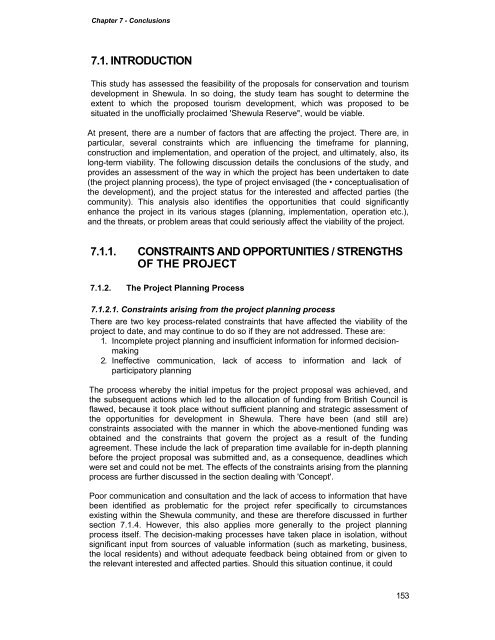Feasibility Study of Proposed Tourism Dev in Shewula, NE ...
Feasibility Study of Proposed Tourism Dev in Shewula, NE ...
Feasibility Study of Proposed Tourism Dev in Shewula, NE ...
Create successful ePaper yourself
Turn your PDF publications into a flip-book with our unique Google optimized e-Paper software.
Chapter 7 - Conclusions<br />
7.1. INTRODUCTION<br />
This study has assessed the feasibility <strong>of</strong> the proposals for conservation and tourism<br />
development <strong>in</strong> <strong>Shewula</strong>. In so do<strong>in</strong>g, the study team has sought to determ<strong>in</strong>e the<br />
extent to which the proposed tourism development, which was proposed to be<br />
situated <strong>in</strong> the un<strong>of</strong>ficially proclaimed '<strong>Shewula</strong> Reserve", would be viable.<br />
At present, there are a number <strong>of</strong> factors that are affect<strong>in</strong>g the project. There are, <strong>in</strong><br />
particular, several constra<strong>in</strong>ts which are <strong>in</strong>fluenc<strong>in</strong>g the timeframe for plann<strong>in</strong>g,<br />
construction and implementation, and operation <strong>of</strong> the project, and ultimately, also, its<br />
long-term viability. The follow<strong>in</strong>g discussion details the conclusions <strong>of</strong> the study, and<br />
provides an assessment <strong>of</strong> the way <strong>in</strong> which the project has been undertaken to date<br />
(the project plann<strong>in</strong>g process), the type <strong>of</strong> project envisaged (the • conceptualisation <strong>of</strong><br />
the development), and the project status for the <strong>in</strong>terested and affected parties (the<br />
community). This analysis also identifies the opportunities that could significantly<br />
enhance the project <strong>in</strong> its various stages (plann<strong>in</strong>g, implementation, operation etc.),<br />
and the threats, or problem areas that could seriously affect the viability <strong>of</strong> the project.<br />
7.1.1. CONSTRAINTS AND OPPORTUNITIES / STRENGTHS<br />
OF THE PROJECT<br />
7.1.2. The Project Plann<strong>in</strong>g Process<br />
7.1.2.1. Constra<strong>in</strong>ts aris<strong>in</strong>g from the project plann<strong>in</strong>g process<br />
There are two key process-related constra<strong>in</strong>ts that have affected the viability <strong>of</strong> the<br />
project to date, and may cont<strong>in</strong>ue to do so if they are not addressed. These are:<br />
1. Incomplete project plann<strong>in</strong>g and <strong>in</strong>sufficient <strong>in</strong>formation for <strong>in</strong>formed decisionmak<strong>in</strong>g<br />
2. Ineffective communication, lack <strong>of</strong> access to <strong>in</strong>formation and lack <strong>of</strong><br />
participatory plann<strong>in</strong>g<br />
The process whereby the <strong>in</strong>itial impetus for the project proposal was achieved, and<br />
the subsequent actions which led to the allocation <strong>of</strong> fund<strong>in</strong>g from British Council is<br />
flawed, because it took place without sufficient plann<strong>in</strong>g and strategic assessment <strong>of</strong><br />
the opportunities for development <strong>in</strong> <strong>Shewula</strong>. There have been (and still are)<br />
constra<strong>in</strong>ts associated with the manner <strong>in</strong> which the above-mentioned fund<strong>in</strong>g was<br />
obta<strong>in</strong>ed and the constra<strong>in</strong>ts that govern the project as a result <strong>of</strong> the fund<strong>in</strong>g<br />
agreement. These <strong>in</strong>clude the lack <strong>of</strong> preparation time available for <strong>in</strong>-depth plann<strong>in</strong>g<br />
before the project proposal was submitted and, as a consequence, deadl<strong>in</strong>es which<br />
were set and could not be met. The effects <strong>of</strong> the constra<strong>in</strong>ts aris<strong>in</strong>g from the plann<strong>in</strong>g<br />
process are further discussed <strong>in</strong> the section deal<strong>in</strong>g with 'Concept'.<br />
Poor communication and consultation and the lack <strong>of</strong> access to <strong>in</strong>formation that have<br />
been identified as problematic for the project refer specifically to circumstances<br />
exist<strong>in</strong>g with<strong>in</strong> the <strong>Shewula</strong> community, and these are therefore discussed <strong>in</strong> further<br />
section 7.1.4. However, this also applies more generally to the project plann<strong>in</strong>g<br />
process itself. The decision-mak<strong>in</strong>g processes have taken place <strong>in</strong> isolation, without<br />
significant <strong>in</strong>put from sources <strong>of</strong> valuable <strong>in</strong>formation (such as market<strong>in</strong>g, bus<strong>in</strong>ess,<br />
the local residents) and without adequate feedback be<strong>in</strong>g obta<strong>in</strong>ed from or given to<br />
the relevant <strong>in</strong>terested and affected parties. Should this situation cont<strong>in</strong>ue, it could<br />
153












